Novel Deep-Learning Modulation Recognition Algorithm Using 2D Histograms over Wireless Communications Channels
Abstract
:1. Introduction
- We loosen the prior limitation by proposing a novel MR applicable to flat-fading wireless channels.
- We show that each modulation choice has a distinct two-dimensional in-phase quadrature histogram (2-D IQH), which is beneficially utilized to design a CNN-based MR algorithm.
- In addition to operating over practical wireless environments, the proposed algorithm provides much less complexity when compared to [23,24]. It only requires two CNN deep layers, which greatly shortens the training and recognition times. The conceptual diagram of the proposed receiver is shown in Figure 1.
2. Related Works
3. Preliminary Studies
- The transmitter broadcasts uncorrelated information symbols withwhere is the kth transmit symbol belonging to a constellation of order M, represents the statistical expectation, and * is the complex conjugate operation. Without sacrificing generality, we set to the value of 1. Here, the transmitter picks the constellation from a list of available options based on the strength of the channel.
- The channel gain is modelled as a zero-mean complex Gaussian random variable, with .
- Noise samples are considered to be Additive White zero-mean Gaussian Noise (AWGN) samples that are symmetric, independent, and identically distributed, with variance .
4. Data Generation and Feature Extraction
- We split the incoming signal into its in-phase and quadrature components, and , respectively.
- We determine the maximum and minimum values for each of and .
- We create 80 bins across the entire scale of and .
- We calculate the number of samples that fit inside each grid. This matrix represents the histogram of the received signal. The prior information is visualized in Figure 3.
5. Proposed MR Algorithm
5.1. CNNs Architecture
5.2. Modulation Recognition CNN Structure
6. Simulation Work
6.1. Experimental Environment
6.2. Results and Discussion
7. Conclusions
Author Contributions
Funding
Data Availability Statement
Acknowledgments
Conflicts of Interest
References
- Marey, M.; Mostafa, H. Power of Error Correcting Codes for SFBC-OFDM Classification over Unknown Channels. IEEE Access 2022, 10, 35643–35652. [Google Scholar] [CrossRef]
- Marey, M.; Mostafa, H. STBC Identification for Multi-User Uplink SC-FDMA Asynchronous Transmissions Exploiting Iterative Soft Information Feedback of Error Correcting Codes. IEEE Access 2022, 10, 21336–21346. [Google Scholar] [CrossRef]
- Marey, M.; Mostafa, H.; Alshebeili, S.A.; Dobre, O.A. STBC Recognition for OFDM Transmissions: Channel Decoder Aided Algorithm. IEEE Commun. Lett. 2022, 26, 1658–1662. [Google Scholar] [CrossRef]
- Ansari, S.; Alnajjar, K.A.; Saad, M.; Abdallah, S.; El-Moursy, A.A. Automatic Digital Modulation Recognition Based on Genetic-Algorithm-Optimized Machine Learning Models. IEEE Access 2022, 10, 35643–35652. [Google Scholar] [CrossRef]
- Fu, X.; Gui, G.; Wang, Y.; Gacanin, H.; Adachi, F. Automatic Modulation Classification Based on Decentralized Learning and Ensemble Learning. IEEE Trans. Veh. Technol. 2022, 71, 7942–7946. [Google Scholar] [CrossRef]
- Huynh-The, T.; Nguyen, T.V.; Pham, Q.V.; da Costa, D.B.; Kim, D.S. MIMO-OFDM Modulation Classification Using Three-Dimensional Convolutional Network. IEEE Trans. Veh. Technol. 2022, 71, 6738–6743. [Google Scholar] [CrossRef]
- Marey, M.; Mostafa, H. Turbo Modulation Identification Algorithm for OFDM Software-Defined Radios. IEEE Commun. Lett. 2021, 25, 1707–1711. [Google Scholar] [CrossRef]
- Marey, M.; Mostafa, H. Soft-Information Assisted Modulation Recognition for Reconfigurable Radios. IEEE Wirel. Commun. Lett. 2021, 10, 745–749. [Google Scholar] [CrossRef]
- Li, W.; Shentu, G.; Gao, X. Estimation of Distribution of Primary Channel Periods Based on Imperfect Spectrum Sensing in Cognitive Radio. IEEE Access 2022, 10, 82025–82035. [Google Scholar] [CrossRef]
- Yang, P.; Yang, L.; Kuang, W.; Wang, S. Outage Performance of Cognitive Radio Networks with a Coverage-Limited RIS for Interference Elimination. IEEE Wirel. Commun. Lett. 2022, 11, 1694–1698. [Google Scholar] [CrossRef]
- Kaleem, Z.; Ali, M.; Ahmad, I.; Khalid, W.; Alkhayyat, A.; Jamalipour, A. Artificial Intelligence-Driven Real-Time Automatic Modulation Classification Scheme for Next-Generation Cellular Networks. IEEE Access 2021, 9, 155584–155597. [Google Scholar] [CrossRef]
- Marey, M.; Dobre, O.A.; Mostafa, H. Cognitive Radios Equipped with Modulation and STBC Recognition Over Coded Transmissions. IEEE Wirel. Commun. Lett. 2022, 11, 1513–1517. [Google Scholar] [CrossRef]
- Eldemerdash, Y.A.; Dobre, O.A.; Öner, M. Signal Identification for Multiple-Antenna Wireless Systems: Achievements and Challenges. IEEE Commun. Surv. Tutor. 2016, 18, 1524–1551. [Google Scholar] [CrossRef]
- Huynh-The, T.; Pham, Q.V.; Nguyen, T.V.; Nguyen, T.T.; Ruby, R.; Zeng, M.; Kim, D.S. Automatic Modulation Classification: A Deep Architecture Survey. IEEE Access 2021, 9, 142950–142971. [Google Scholar] [CrossRef]
- Li, Z.; Liu, F.; Yang, W.; Peng, S.; Zhou, J. A Survey of Convolutional Neural Networks: Analysis, Applications, and Prospects. IEEE Trans. Neural Netw. Learn. Syst. 2021, 1–21. [Google Scholar] [CrossRef] [PubMed]
- Wani, A.; S, R.; Khaliq, R. SDN-based intrusion detection system for IoT using deep learning classifier (IDSIoT-SDL). CAAI Trans. Intell. Technol. 2021, 6, 281–290. [Google Scholar] [CrossRef]
- Shrikant, M.; Piyush, K.; Suyel, N.; Uma, T. Experience replay-based deep reinforcement learning for dialogue management optimisation. ACM Trans. Asian Low-Resour. Lang. Inf. Process. 2022, 1–28. [Google Scholar] [CrossRef]
- Hooshmand, M.K.; Hosahalli, D. Network anomaly detection using deep learning techniques. CAAI Trans. Intell. Technol. 2022, 7, 228–243. [Google Scholar] [CrossRef]
- Das, S.; Namasudra, S. Multi-Authority CP-ABE-Based Access Control Model for IoT-Enabled Healthcare Infrastructure. IEEE Trans. Ind. Inform. 2022. [Google Scholar] [CrossRef]
- Gasparin, A.; Lukovic, S.; Alippi, C. Deep learning for time series forecasting: The electric load case. CAAI Trans. Intell. Technol. 2022, 7, 1–25. [Google Scholar] [CrossRef]
- Kanak, M.; Madhushi, V.; Gaurav, S.; Suyel, N. QEST: Quantized and efficient scene text detector using deep learning. ACM Trans. Asian Low-Resour. Lang. Inf. Process. 2022, 1–18. [Google Scholar] [CrossRef]
- Kumar, A.; Abhishek, K.; Shah, K.; Namasudra, S.; Kadry, S. A novel elliptic curve cryptography-based system for smart grid communication. Int. J. Web Grid Serv. 2021, 17, 321–342. [Google Scholar] [CrossRef]
- Peng, S.; Jiang, H.; Wang, H.; Alwageed, H.; Zhou, Y.; Sebdani, M.M.; Yao, Y.D. Modulation Classification Based on Signal Constellation Diagrams and Deep Learning. IEEE Trans. Neural Netw. Learn. Syst. 2019, 30, 718–727. [Google Scholar] [CrossRef] [PubMed]
- Kumar, Y.; Sheoran, M.; Jajoo, G.; Yadav, S.K. Automatic Modulation Classification Based on Constellation Density Using Deep Learning. IEEE Commun. Lett. 2020, 24, 1275–1278. [Google Scholar] [CrossRef]
- Lin, X.; Dobre, O.A.; Ngatched, T.M.N.; Eldemerdash, Y.A.; Li, C. Joint Modulation Classification and OSNR Estimation Enabled by Support Vector Machine. IEEE Photonics Technol. Lett. 2018, 30, 2127–2130. [Google Scholar] [CrossRef]
- Marey, M.; Dobre, O.A. Blind Modulation Classification Algorithm for Single and Multiple-Antenna Systems Over Frequency-Selective Channels. IEEE Signal Process. Lett. 2014, 21, 1098–1102. [Google Scholar] [CrossRef]
- Krizhevsky, A.; Sutskever, I.; Hinton, G.E. ImageNet Classification with Deep Convolutional Neural Networks. In Proceedings of the Advances in Neural Information Processing Systems, Lake Tahoe, NV, USA, 3–6 December 2012; Pereira, F., Burges, C.J.C., Bottou, L., Weinberger, K.Q., Eds.; Curran Associates, Inc.: Nice, France, 2012; Volume 25. [Google Scholar]
- Szegedy, C.; Liu, W.; Jia, Y.; Sermanet, P.; Reed, S.; Anguelov, D.; Erhan, D.; Vanhoucke, V.; Rabinovich, A. Going deeper with convolutions. In Proceedings of the 2015 IEEE Conference on Computer Vision and Pattern Recognition (CVPR), Boston, MA, USA, 7–12 June 2015; pp. 1–9. [Google Scholar] [CrossRef]
- Marey, M. Soft-Information Aided Channel Estimation with IQ Imbalance for Alternate-Relaying OFDM Cooperative Systems. IEEE Wirel. Commun. Lett. 2018, 7, 308–311. [Google Scholar] [CrossRef]
- Di Renna, R.B.; De Lamare, R.C. Joint Channel Estimation, Activity Detection and Data Decoding Based on Dynamic Message-Scheduling Strategies for mMTC. IEEE Trans. Commun. 2022, 70, 2464–2479. [Google Scholar] [CrossRef]
- Xie, X.; Yang, G.; Jiang, M.; Ye, Q.; Yang, C.F. A Kind of Wireless Modulation Recognition Method Based on DenseNet and BLSTM. IEEE Access 2021, 9, 125706–125713. [Google Scholar] [CrossRef]
- Jdid, B.; Hassan, K.; Dayoub, I.; Lim, W.H.; Mokayef, M. Machine Learning Based Automatic Modulation Recognition for Wireless Communications: A Comprehensive Survey. IEEE Access 2021, 9, 57851–57873. [Google Scholar] [CrossRef]
- Marey, M.; Steendam, H. The Effect of Narrowband Interference on Frequency Ambiguity Resolution for OFDM. In Proceedings of the IEEE Vehicular Technology Conference, Montreal, QC, Canada, 25–28 September 2006. [Google Scholar]
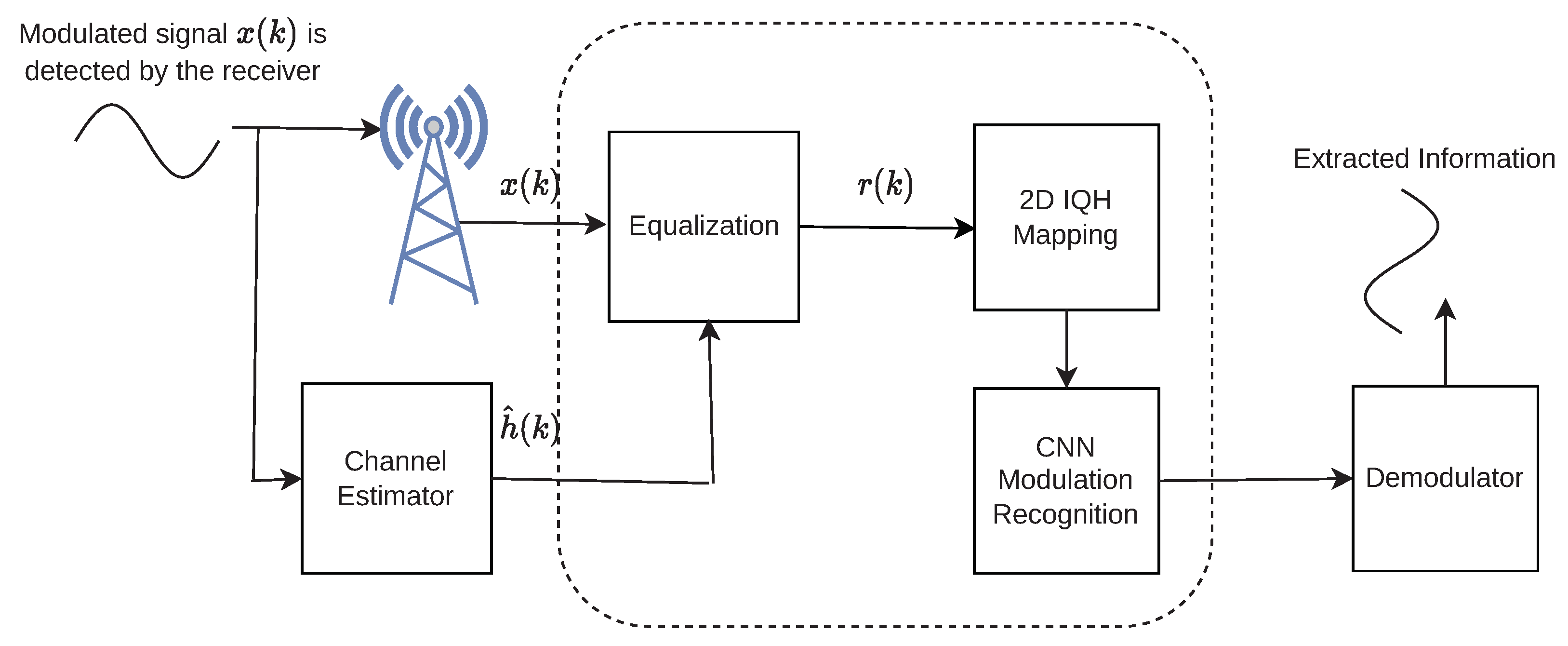
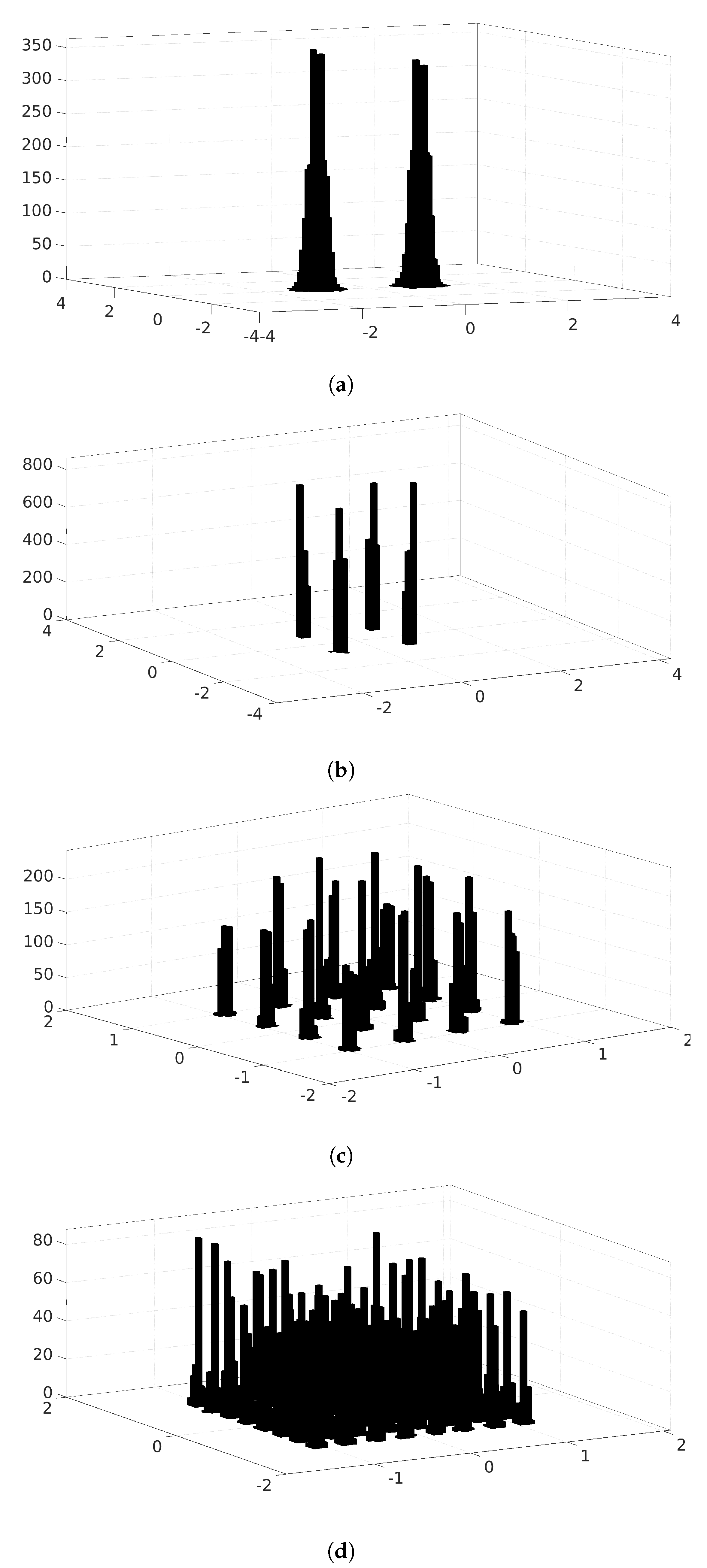
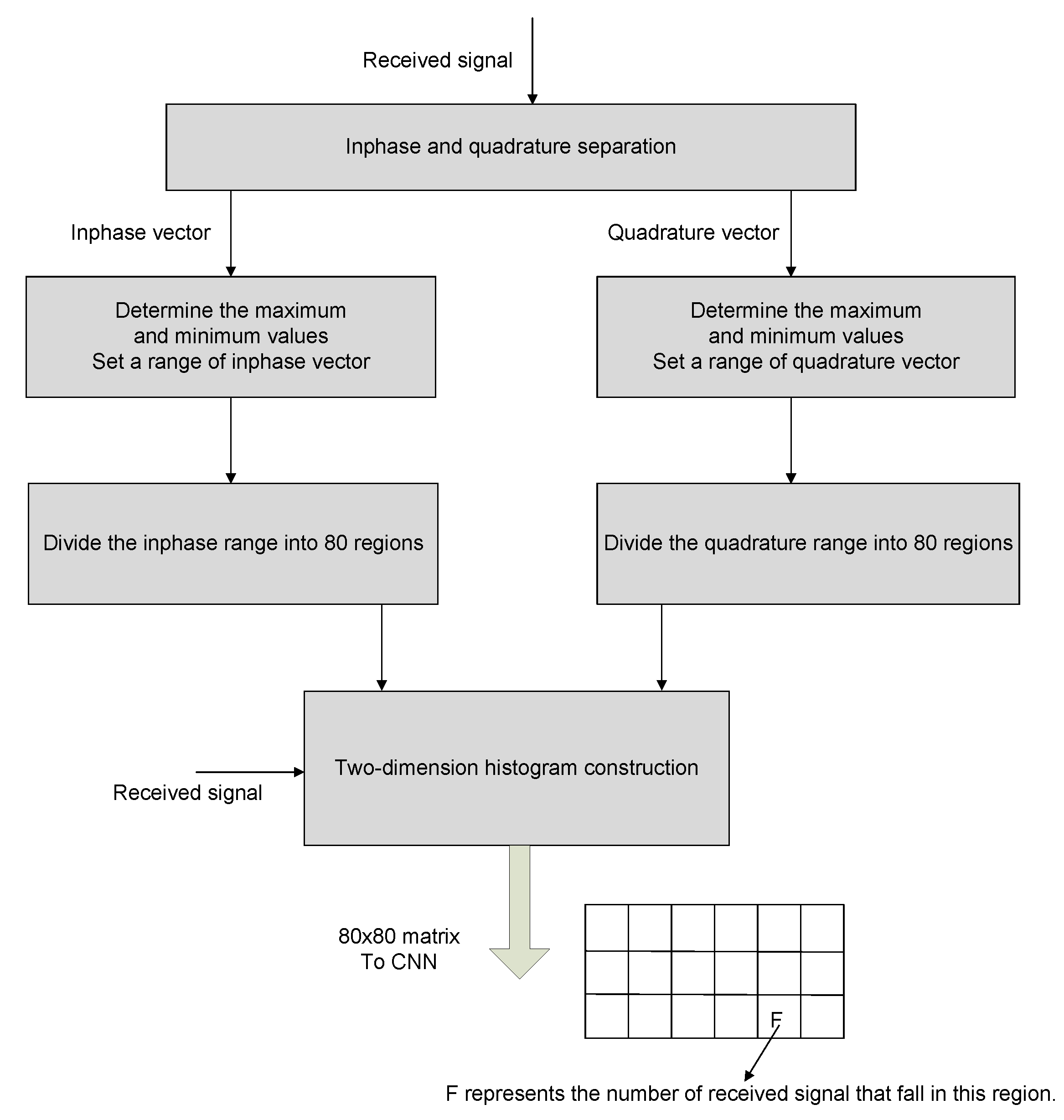
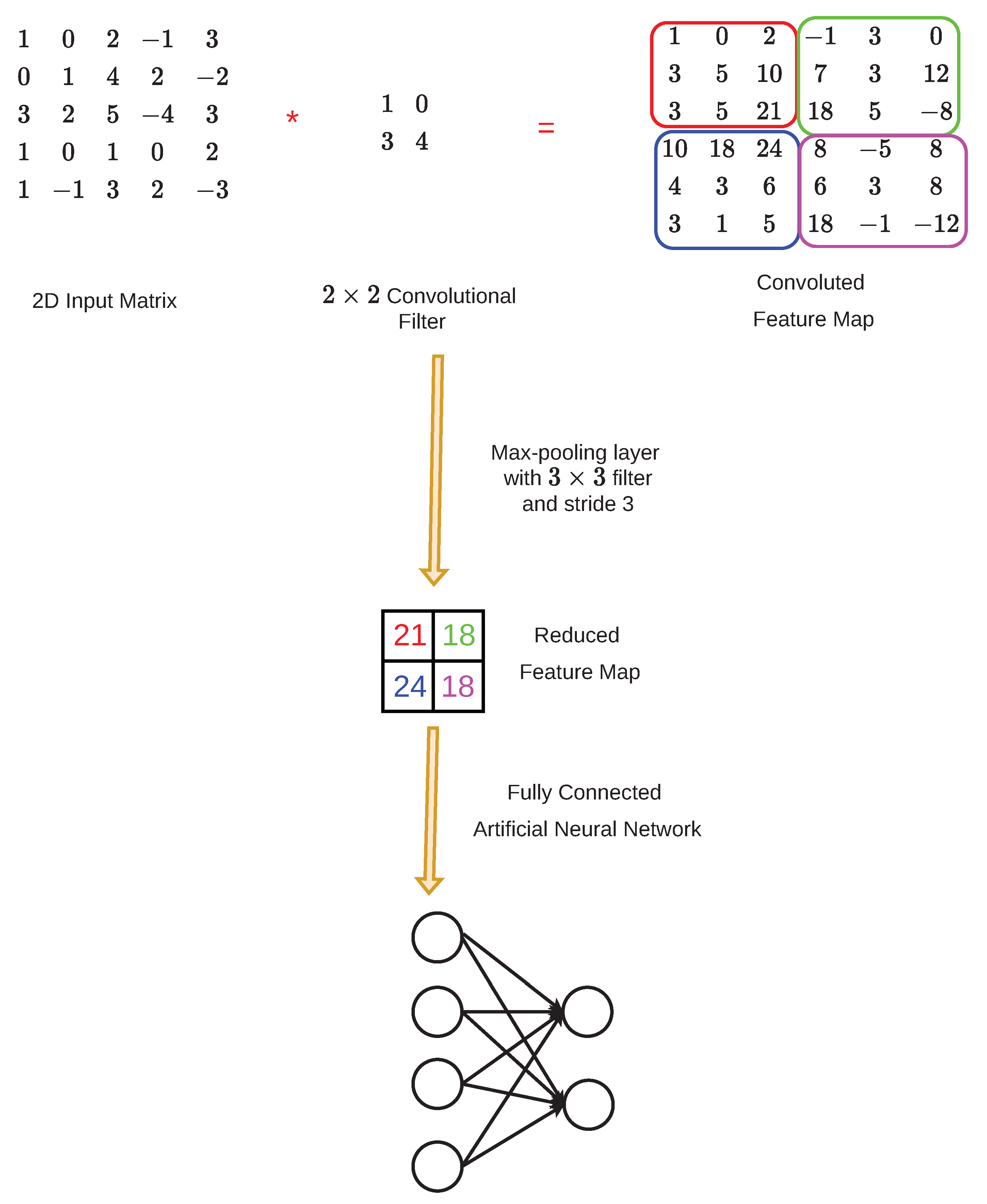
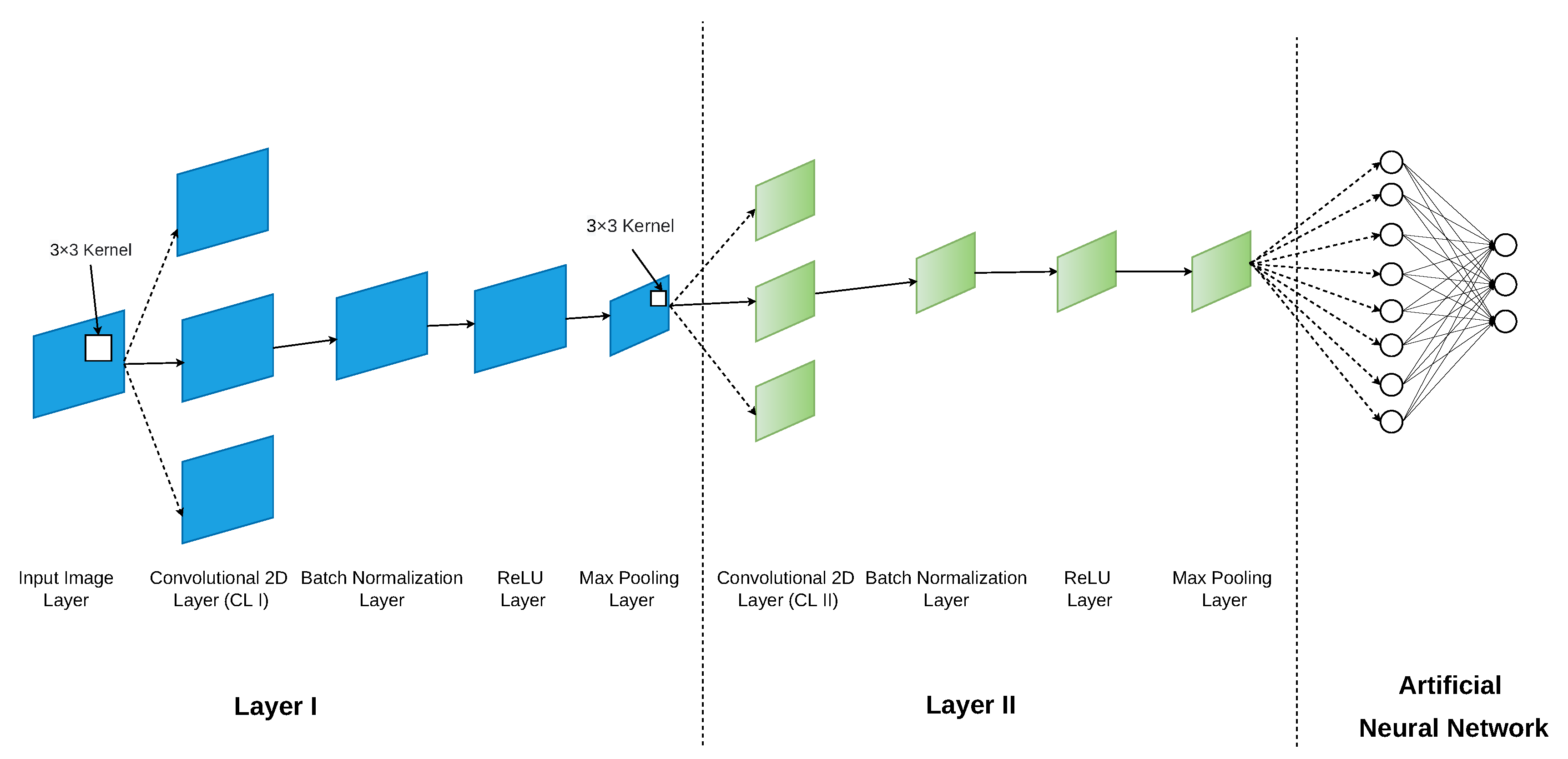
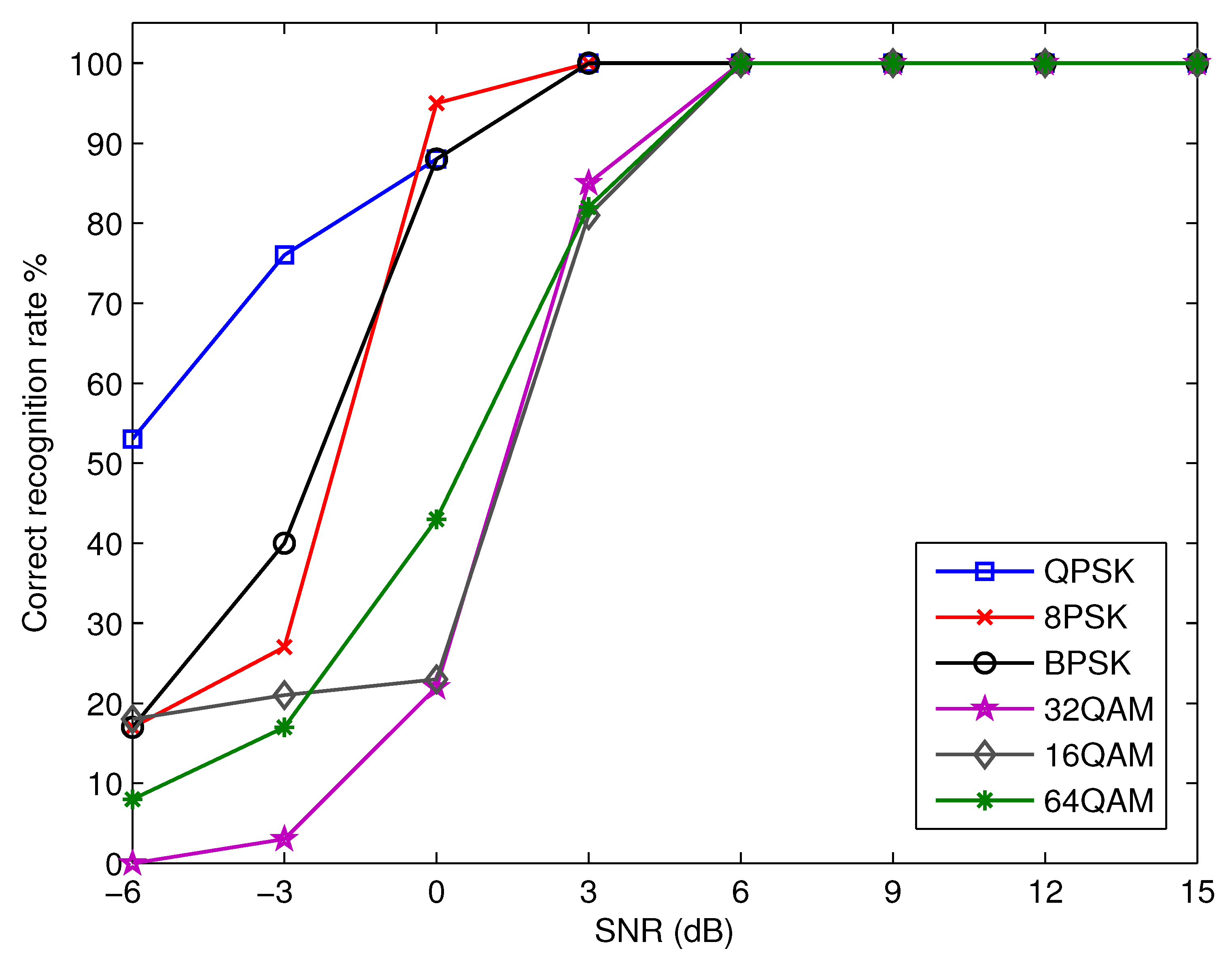
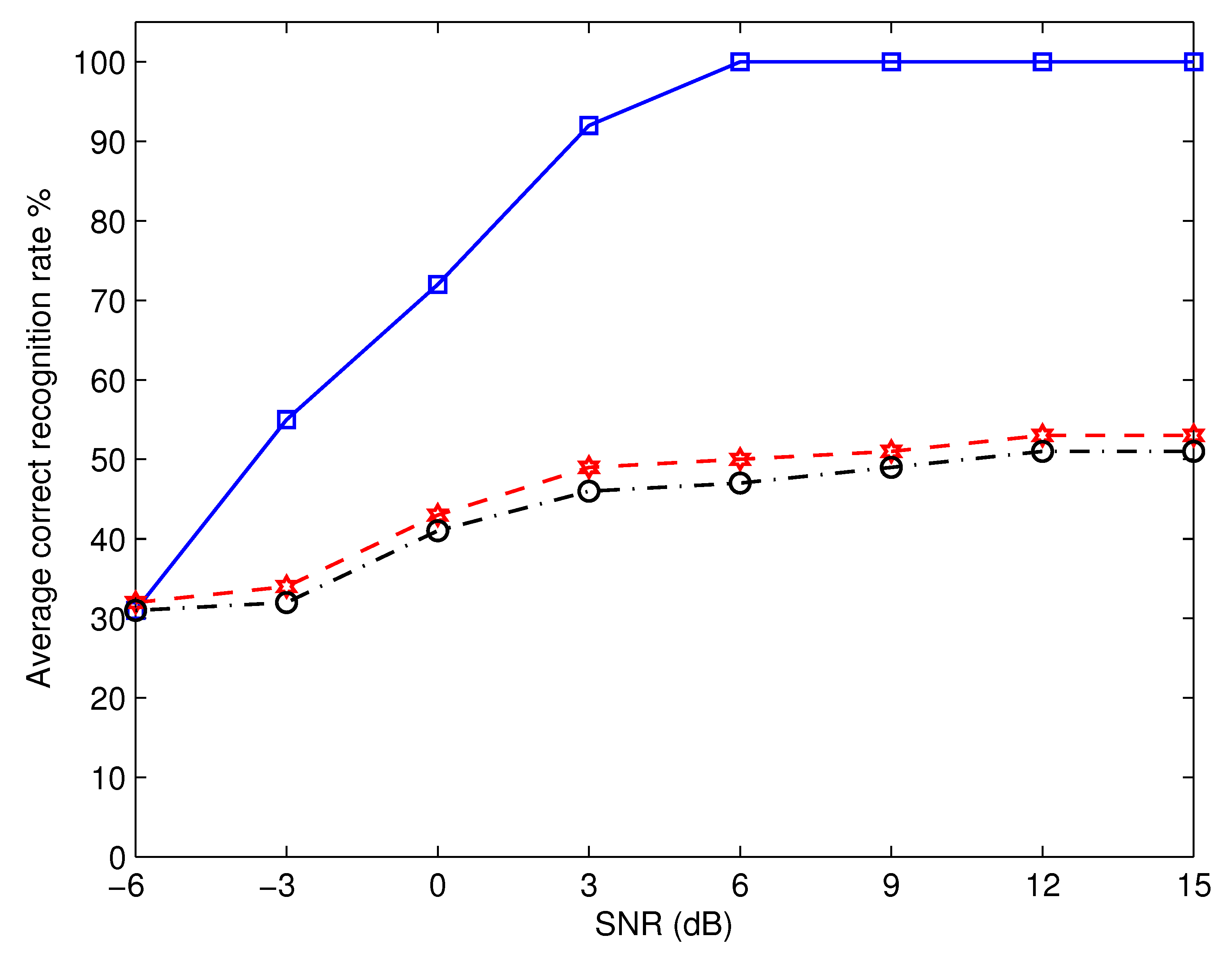

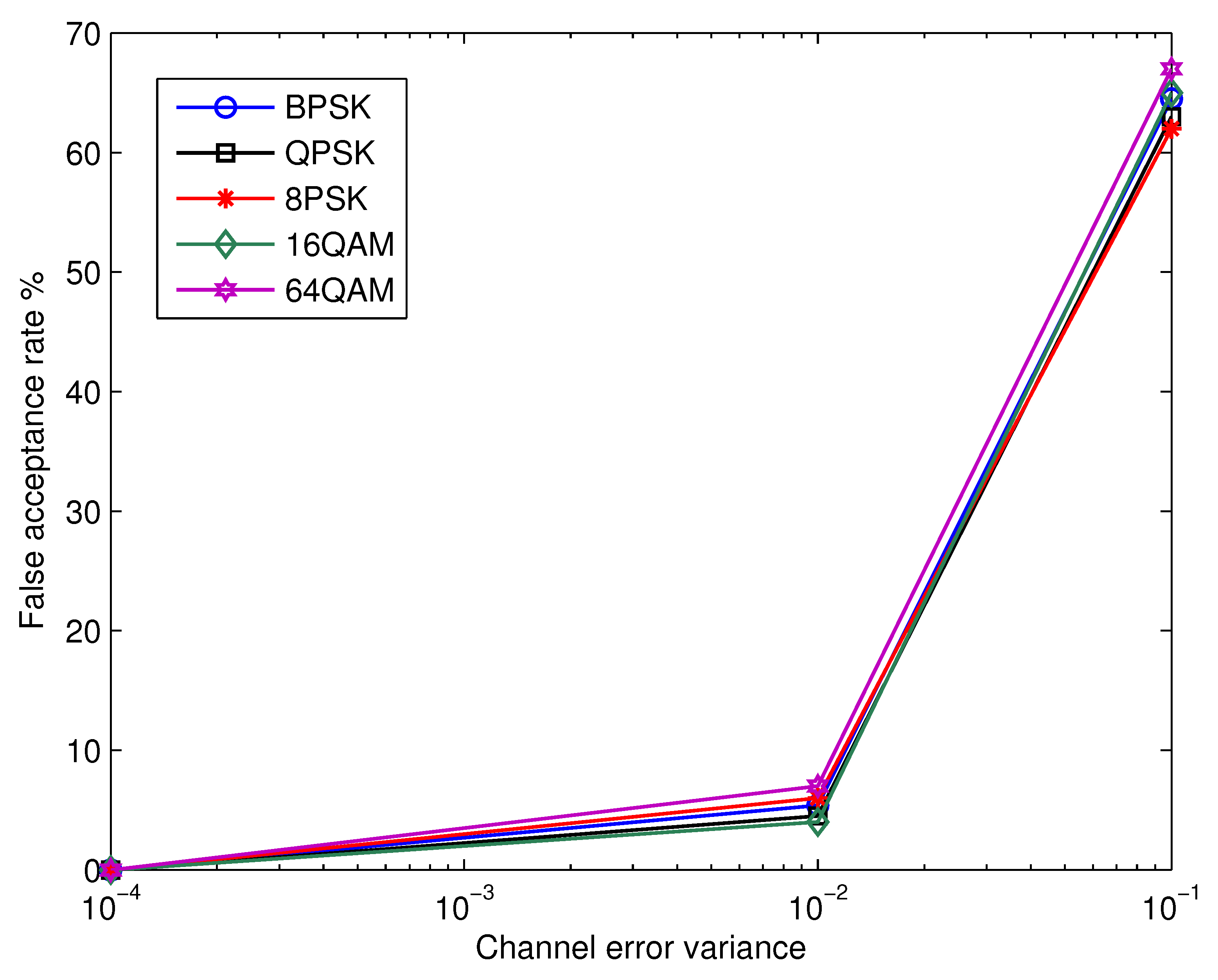
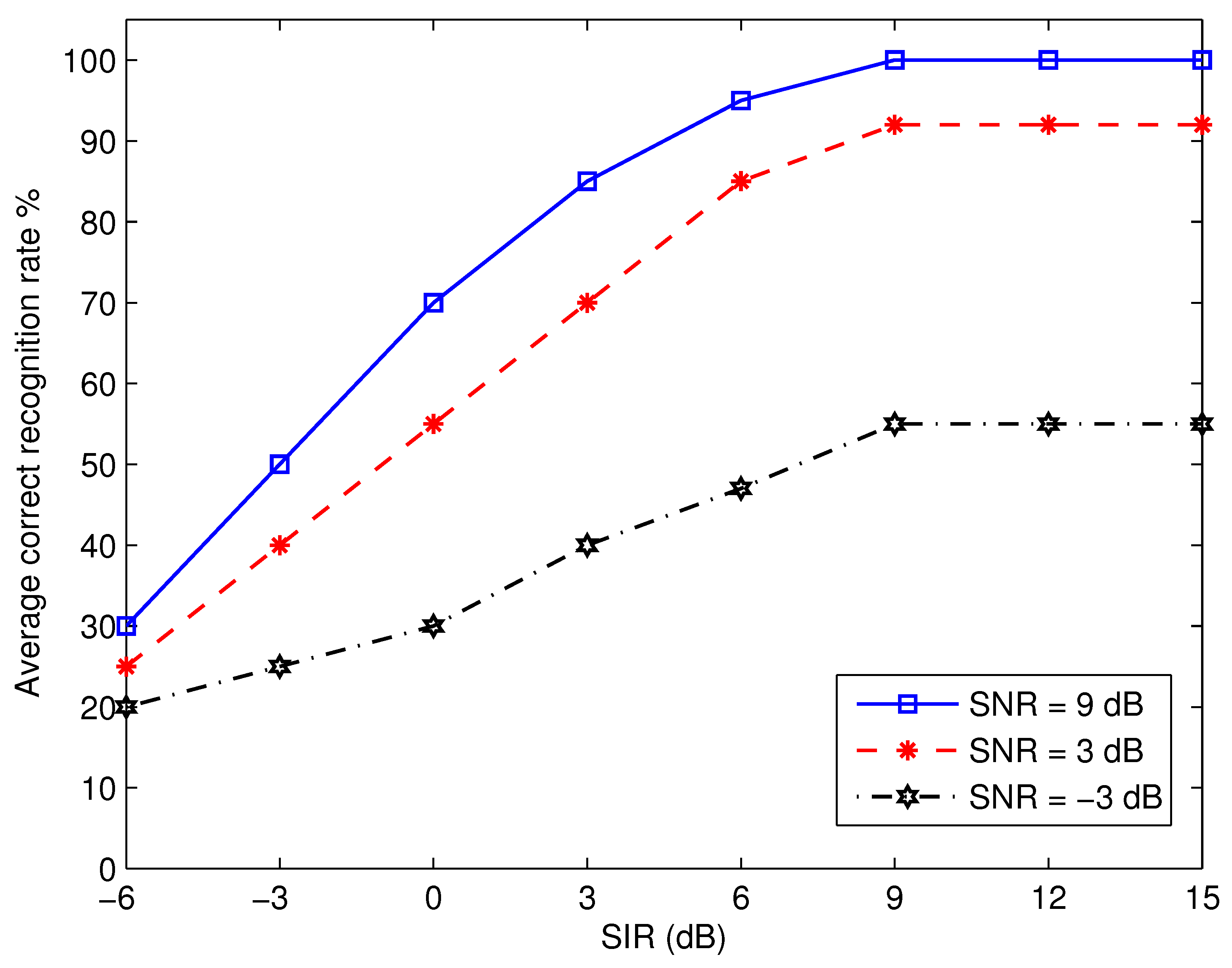
| (SNR = −6 dB, BPSK) | (SNR = −6 dB, QPSK) | … | (SNR = 15 dB, 64QAM) | |
|---|---|---|---|---|
| 8192 Samples | . | |||
| . | ||||
| . | ||||
| . | ||||
| . |
| CNN Parameter | Type/Value |
|---|---|
| Optimizer | Adam |
| Initial Learning Rate | 0.001 |
| Decay Rate of Squared Gradient Moving Average | 0.99 |
| Max Number of Epochs | 10 |
| Mini Batch Size | 64 |
| Number of Deep Layers | 2 |
| Number of Filters in Each Layer | 128 |
| Processor | Intel(R) Core(TM) i7-4790K CPU @ 4.00 GHz |
|---|---|
| RAM | 16 GB |
| Graphics Card | AMD Radeon (TM) R9 390 Series |
| SSD | Samsung SSD 870 EVO 500 GB |
| Operating System | Ubuntu 22.04.1 LTS |
| Software | Matlab-R2022b |
| BPSK | QPSK | 8PSK | 8QAM | 32QAM | 64QAM | |
|---|---|---|---|---|---|---|
| BPSK | 100 | 0 | 0 | 0 | 0 | 0 |
| QPSK | 0 | 100 | 0 | 0 | 0 | 0 |
| 8PSK | 0 | 0 | 100 | 0 | 0 | 0 |
| 8QAM | 0 | 0 | 0 | 100 | 0 | 0 |
| 32QAM | 0 | 0 | 0 | 0 | 100 | 0 |
| 64QAM | 0 | 0 | 0 | 0 | 0 | 100 |
| BPSK | QPSK | 8PSK | 8QAM | 32QAM | 64QAM | |
|---|---|---|---|---|---|---|
| BPSK | 95 | 1 | 1 | 1 | 1 | 1 |
| QPSK | 1 | 96 | 1 | 1 | 1 | 0 |
| 8PSK | 1 | 2 | 94 | 1 | 1 | 1 |
| 8QAM | 1 | 1 | 1 | 95 | 1 | 1 |
| 32QAM | 1 | 1 | 1 | 2 | 94 | 1 |
| 64QAM | 1 | 1 | 1 | 1 | 2 | 94 |
| BPSK | QPSK | 8PSK | 8QAM | 32QAM | 64QAM | |
|---|---|---|---|---|---|---|
| BPSK | 38 | 15 | 14 | 11 | 9 | 13 |
| QPSK | 10 | 37 | 16 | 15 | 12 | 10 |
| 8PSK | 13 | 19 | 38 | 12 | 10 | 8 |
| 8QAM | 7 | 8 | 20 | 36 | 15 | 14 |
| 32QAM | 5 | 10 | 7 | 21 | 34 | 23 |
| 64QAM | 7 | 8 | 14 | 16 | 22 | 33 |
Publisher’s Note: MDPI stays neutral with regard to jurisdictional claims in published maps and institutional affiliations. |
© 2022 by the authors. Licensee MDPI, Basel, Switzerland. This article is an open access article distributed under the terms and conditions of the Creative Commons Attribution (CC BY) license (https://creativecommons.org/licenses/by/4.0/).
Share and Cite
Marey, A.; Marey, M.; Mostafa, H. Novel Deep-Learning Modulation Recognition Algorithm Using 2D Histograms over Wireless Communications Channels. Micromachines 2022, 13, 1533. https://doi.org/10.3390/mi13091533
Marey A, Marey M, Mostafa H. Novel Deep-Learning Modulation Recognition Algorithm Using 2D Histograms over Wireless Communications Channels. Micromachines. 2022; 13(9):1533. https://doi.org/10.3390/mi13091533
Chicago/Turabian StyleMarey, Amr, Mohamed Marey, and Hala Mostafa. 2022. "Novel Deep-Learning Modulation Recognition Algorithm Using 2D Histograms over Wireless Communications Channels" Micromachines 13, no. 9: 1533. https://doi.org/10.3390/mi13091533
APA StyleMarey, A., Marey, M., & Mostafa, H. (2022). Novel Deep-Learning Modulation Recognition Algorithm Using 2D Histograms over Wireless Communications Channels. Micromachines, 13(9), 1533. https://doi.org/10.3390/mi13091533





